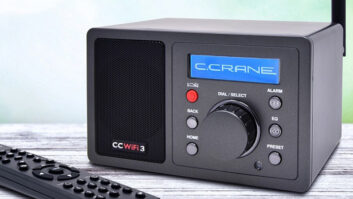The author writes the column Radionet for the international edition of Radio World.

The Kerbango Internet Radio: What Internet radio looked like in 2000. Radio World has been covering the convergence of radio and the Internet since the mid-1990s. Yes, we were there when RealPlayer v.1 was launched.
In those early days of audio streaming, we were on the lookout for the first “true” Internet radio. This would be a radio-like appliance that would tune Web broadcasters the same way that one tunes to AM and FM stations.
At the time, it seemed reasonable to assume that Internet radio receivers would replace AM/FM receivers at home in the kitchen, at the office, and — if someone could figure out how to make the Internet wireless — in the car as well.
In January 2000, our vigil appeared to have been rewarded by the appearance of the Kerbango Internet Radio. This was a retro-style radio receiver with stereo speakers, an LCD display, a broadband connection port, and the ability to tune Web stations as if they were AM or FM broadcasters.
Sadly, the Kerbango never made it to market. The developer was bought out by 3Com. That company was subsequently hammered by the dot.com crash: In a cost-cutting move, 3com killed the Kerbango.
Since that time, companies such as Grace Digital Audio, Logitech and Sangean have released their versions of standalone Internet radios. They are selling enough of these devices to justify their continued manufacture.
This said, standalone Internet radios have not taken over the home, office or car; even with the help of 3G/4G and Wi-Fi. So what happened?
App over appliance
Internet radio has not succeeded as a mass-market appliance. But it is definitely succeeding as a mass-market application — or “app” — to varying degrees around the world.

The Grace Digital Mondo: Internet radio of 2012. In the United States, according to Fred Jacobs, president of Jacobs Media, “Nearly four in every 10 people of the 57,300-plus respondents to our eighth national ‘TechSurvey’ listen to Internet radio weekly, mainly on PC but also on mobile phones. As well, based on the 170 stations who responded, most stations in the top 100 U.S. markets are streaming their signals on the Web.”
In the United Kingdom, growth is far slower. “Only about four percent of people here listen to Internet radio,” said James Cridland, managing director of Media U.K. and a self-described “radio futurologist.”
“In Germany, the percentage stands higher at 10 percent. The differences may be due to wider choice on digital radio, and music licensing fees,” he said. “It is very expensive for U.K. pure-play Internet broadcasters to stream music.” Again, most of this listening is done on PCs, with some being heard on wireless devices as well.
In Thailand, Internet radio “is basically in its infancy,” said Lawan Chumsai na Ayudhya, group program director with the Bec-Tero Radio company in Bangkok. “We cannot say it has reached a point of success due to many factors such as infrastructure, and the fact that radio audiences still prefer traditional FM stations.”
This said, the Bec-Tero Radio Co. is already streaming is two FM stations online, and has launched three standalone Web-only stations branded as Rad Radio (Dance), Tofu Pop Radio (Asian Music) and Rock On Radio (Rock).
The re-emergence

Bec-Tero Radio Bangkok Group PD Lawan Chumsai na Ayudhya, with her company’s five radio sites. The company has made this move because it believes Internet radio as an app “has a future, and it is important that we start building the foundations now, if we want to grow this part of our business,” Ayudhya said.
Meanwhile, in South Africa, “Internet radio is fairly new in our country and there is no industry body that exists to measure the handful of stations that do exist,” said Matona Sakupwanya, general manager of the Radio Advertising Bureau South Africa. Based on what the RABSA does know, “In terms of traditional radio, the radio receiver is still the most used to listen to radio,” Sakupwanya said. “24.7 percent listen via cellphone, 3.7 percent desktop and 0.4 percent via DSTV [digital satellite TV].”
So much has changed since Radionet began its Internet radio vigil that it is hardly surprising that we predicted Internet radio’s rise as an appliance, rather than an application. Back then, standalone radios were a known quantity; streaming computers and cellphones were not.
Still, there is one consolation for those of us who love actual radio receivers, and it is that standalone Internet radios are getting more traction in the marketplace. The reason: If you listen to SiriusXM in your car and on your iPhone, you want that content on your kitchen radio, bedside alarm clock and legacy stereo system, said Grace Digital Co-Founder Greg Fadul. This is why Grace Digital offers nine Internet radios/Wi-Fi music players and plans to expand the line in 2013.
James Careless reports on the industry for Radio World from Ottawa, Canada.







